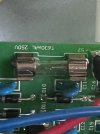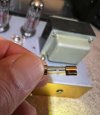My apologies in advance as I'm sure I've done something stupid. I have a DSL1 CR which I've played with headphones and the manual specifically states to disconnect the speaker before doing so. So I figured do the same on my DSL 100HR and some badness has definitely occurred. The volume was very weak and distorted through the headphones so I kept increasing the volume and sure enough something blew. There was a flash of light and then no sound. The tubes look fine and the mains fuse looks fine. From what I've read I've likely blown the HT fuse or output transformer. I will take it to Guitar Center for them to have a look. What is the most likely problem, and can it be fixed? And why is it ok to disconnect the speaker cable on the DSL1 but not on the DSL100?
Thanks in advance. I'm very sad .
.
Thanks in advance. I'm very sad
 .
.
 to the MF!
to the MF!


